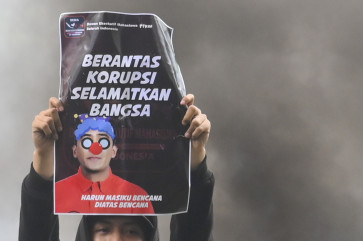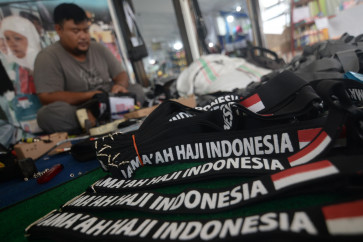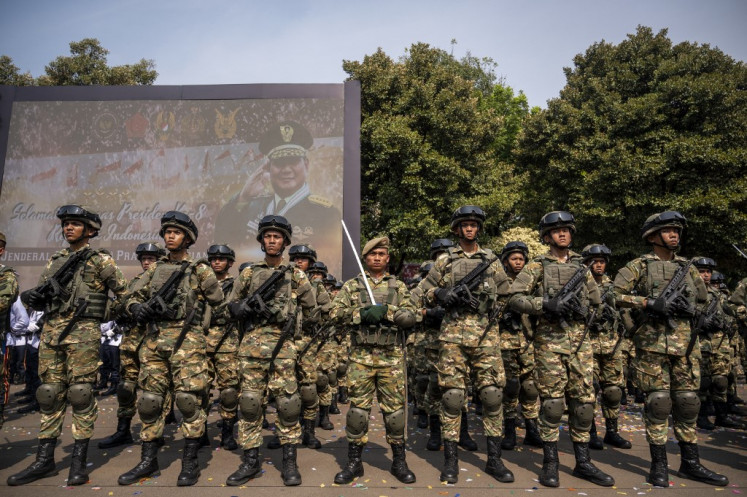Making a mark across Indonesia
Documented: âWe asked the artists from each city to write their own street art history,â Andi said during the exhibition at a community house in Pasar Minggu
Change text size
Gift Premium Articles
to Anyone

D
span class="caption" style="width: 498px;">Documented: 'We asked the artists from each city to write their own street art history,' Andi said during the exhibition at a community house in Pasar Minggu.
The recently concluded Indonesian Street Art Database (ISAD) Festival was a display of important archives and documentaries about graffiti, murals and tagging on the streets of 12 cities across Indonesia.
The archives are important, providing rare insight into street art in small towns across the archipelago that would otherwise be unknown.
ISAD director Andi Riyanto, who goes by Andi RHARHARHA, said that the festival was intended to foster collaboration and networking among street artists in 23 cities.
However, due to technical reasons, the festival gathered artists and exhibited works from only 12 cities: Banda Aceh, Aceh; Jakarta; Kuningan, West Java; Medan, North Sumatra; Tangerang, Banten; and Kendal, Kudus, Magelang, Pekalongan, Semarang, Surakarta and Wonosobo in Central Java.
'We asked the artists from each city to write their own street art history,' Andi said during the exhibition at a community house in Pasar Minggu, South Jakarta, that closed last week.
The festival also produced an exhibition catalogue to give readers a deeper understanding of street art in Indonesia.
Much of the street art in the cities addressed the same political issues: corruption and the murder of Munir, the human rights activist.

Some of the art, however, was more personally expressive, such as tagging the artist's name or nickname on the walls.
'Don't underestimate the power of street art,' Andi said, using the killing of Ahmadiyah followers in Cikeusik, Banten in February 2011 as an example. 'Within only one day after the tragedy in Cikeusik, 20 cities had 'Berbeda dan Merdeka 100%' on their walls.'
The slogan, which means 100 percent different and free, was originally a call for street artists to spray graffiti, paint murals or glue stickers to spread the word that Indonesians needed to respect differences to become 100 percent free.
It was launched a month before the Cikeusik killings happened.
Meanwhile, other street art addressed pet causes, such as the high cost of public transportation, the need for bicycle lanes, plans to demolish a heritage building ' or just encouraging messages about life in the city.
ISAD, however, did not present itself as a judge of the art's quality.
Established in 2011, ISAD works to document street arts in Indonesia by utilizing networks and social media. It is an open initiative; anyone can submit pictures of street arts to ISAD's Facebook page. 'Every Monday, we open submissions for pictures of street arts,' Andi said.
The catalogue also has a brief history of street art in the cities surveyed by the exhibition, written by the taggers themselves.
Artists from Pekalongan and Wonosobo, for example, connected the emergence of street art with the rise of breakdancing (in Pekalongan) or hip-hop music (in Wonosobo).
Meanwhile, in Banda Aceh, street art emerged during the tail end of the decades-long separatist movement in the time before the tsunami in 2006.

According to the catalogue, at that time, there were many tags on the streets of Banda Aceh that read 'Referendum' at that time.
Many of the artists' accounts mention that members of the public and the authorities considered their works 'vandalism'.
The taggers in Kuningan, however, offered a fresh take. 'Kuningan, a small town in the foot of the Ciremai Mountains, is among the cleanest cities in the eastern part of West Java. Although it has clinched an Adipura [environmental] Trophy several times, the town is visually uninteresting. Therefore in 2005, a group of young people, with their available talent, tried to decorate the city walls with visual works,' the history said.
Andi said that artists in Indonesia still have to widen their references about street art.
Considered by the authorities and members of the public as a form of vandalism, street art can sometimes go beyond self expression.
Andi's reference is BNE, a New York-based street artist who tags his name in cities across the globe. He later set up a foundation to provide clean water to some cities he traveled to.
'Street art is done by a generation that is in the process of growing up. They need more references, to read more books and to watch more documentaries. We want to encourage them to make a mark,' Andi said.



' Photos courtesy of ISAD Festival
For more information, visit ISAD at facebook.com/indonesianstreetartdatabase or at @I_S_A_D on Twitter and on Instagram.









